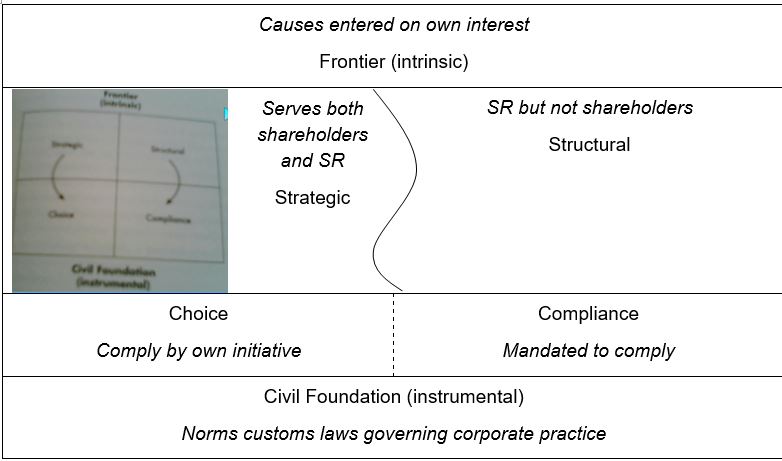Martin (2002)
General Review:
Explores the form and degrees of corporate virtue by applying a Virtue Matrix that enables management to assess the market forces influencing their ability to act responsible, and make decisions how to act responsible compared to the market forces.
Core Theory (logical explanation or testable model of interaction):
Considers CR as a service, subject to market pressures that limits its supply.
Core concepts (abstract idea or a mental symbol):
CR initiatives securing or enhancing shareholder value considered instrumental, doing what is thought as the right thing to do is considered intrinsic.
Core framework (structure used to outline, address or solve complex issues):
Core models (pattern, plan or description showing main object or workings of concept):
P103

| Causes entered on own interest Frontier (intrinsic) | |
| Serves both shareholders and SR Strategic | SR but not shareholders Structural |
| Choice Comply by own initiative | Compliance Mandated to comply |
| Civil Foundation (instrumental) Norms customs laws governing corporate practice |
Strategic drives towards best practice imitation (based on profit making strategy)
Structural drives towards industry or government compliance (based on network corporation)
Both enhances civil foundation that is increasing the social value
Methods used:
Case study / examples.
Cites:
Relatedness to objective:
Frontier activities driven by leaders own interest only way to create benefit.
Different levels of civil foundations in developed and developing countries. Consumer perception of the level in developed countries, vs the opportunity the developing countries offer due to a lower level. And competitive position on cost due to the difference.
P97 “The most significant impediment to the growth of corporate virtue is a dearth of vision among business leaders.” Lack of imagination and motivation.
Relatedness to questions:
Arguments/points made (set of one or more declarative sentences):
STRATEGY P94 “For a company to earn public credit for its behaviour, it has to engage in activities that reside in the frontier. That is where the public sees obvious social or environmental benefits to be gained, but little corporate willingness to realize them.”
STRUCTURAL p98 “if consumers were enthustiastic and likely to reward corporations for a particular innovation, that innovation would be located on the strategic frontier.” – Most effective weapon is collective action.
Criticises:
Supports:
Critique:
Matrix usability is good but unfortunately, Lack of empirical research.






